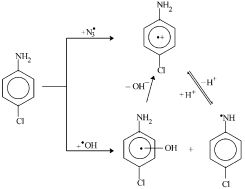Radiation chemical oxidation of aniline derivatives
Abstract
The reactions of ˙OH, O˙− and N3˙ with chloro- and hydroxy-anilines were studied by

* Corresponding authors
a
National Centre for Free Radical Research, Department of Chemistry, University of Pune, Pune, India
E-mail:
bsmr@chem.unipune.ernet.in
Fax: + 91 20 5651728
b Radiation Chemistry and Chemical Dynamics Division, Bhabha Atomic Research Centre, Mumbai, India
The reactions of ˙OH, O˙− and N3˙ with chloro- and hydroxy-anilines were studied by

 Please wait while we load your content...
Something went wrong. Try again?
Please wait while we load your content...
Something went wrong. Try again?
T. S. Singh, S. P. Gejji, B. S. M. Rao, H. Mohan and J. P. Mittal, J. Chem. Soc., Perkin Trans. 2, 2001, 1205 DOI: 10.1039/B009020O
To request permission to reproduce material from this article, please go to the Copyright Clearance Center request page.
If you are an author contributing to an RSC publication, you do not need to request permission provided correct acknowledgement is given.
If you are the author of this article, you do not need to request permission to reproduce figures and diagrams provided correct acknowledgement is given. If you want to reproduce the whole article in a third-party publication (excluding your thesis/dissertation for which permission is not required) please go to the Copyright Clearance Center request page.
Read more about how to correctly acknowledge RSC content.
 Fetching data from CrossRef.
Fetching data from CrossRef.
This may take some time to load.
Loading related content
